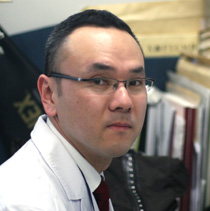
 > Research
> Tomohide Tsukahara[BONE AND SOFT TISSUE TUMORS]
> Research
> Tomohide Tsukahara[BONE AND SOFT TISSUE TUMORS]
Associate Professor
Tomohide Tsukahara, M.D. Ph.D.
PROFESSIONAL EDUCATION
Sapporo Medical University, Sapporo, Japan, M.D., 1994
Sapporo Medical University, Sapporo, Japan, Ph.D., 2004
POSTDOCTORAL EXPERIENCE
None
SELECTED PUBLICATIONS
Autologous CTL response against cancer stem-like cells/cancer-initiating cells of bone malignant fibrous histiocytoma. Kano M, Tsukahara T, Emori M, Murase M, Torigoe T, Kawaguchi S, Wada T, Yamashita T, Sato N. Cancer Sci. 2011 Aug;102(8):1443-7.(PubMed)
Side population cells have the characteristics of cancer stem-like cells/cancer-initiating cells in bone sarcomas. Murase M, Kano M, Tsukahara T, Takahashi A, Torigoe T, Kawaguchi S, Kimura S, Wada T, Uchihashi Y, Kondo T, Yamashita T, Sato N. Br J Cancer. 2009 Oct 20;101(8):1425-32.(PubMed)
HLA-A*0201-restricted CTL epitope of a novel osteosarcoma antigen, papillomavirus binding factor. Tsukahara T, Kawaguchi S, Torigoe T, Takahashi A, Murase M, Kano M, Wada T, Kaya M, Nagoya S, Yamashita T, Sato N. J Transl Med. 2009 Jun 12;7:44.(PubMed)
Identification of human autologous cytotoxic T-lymphocyte-defined osteosarcoma gene that encodes a transcriptional regulator, papillomavirus binding factor. Tsukahara T, Nabeta Y, Kawaguchi S, Ikeda H, Sato Y, Shimozawa K, Ida K, Asanuma H, Hirohashi Y, Torigoe T, Hiraga H, Nagoya S, Wada T, Yamashita T, Sato N. Cancer Res. 2004 Aug 1;64(15):5442-8.
(PubMed)

Research works in our team is focused on establishment of immunotherapy for bone and soft tissue sarcoma. We perform clinical peptide vaccination phase I trials, identify specific antigens of cancer stem-like cells/cancer-initiating cells, and develop artificial antibodies against HLA/peptide complex using antibody engineering technology.
As the first, we identified osteosarcoma-associated antigen PBF and 12-mer CTL epitope in the context of HLA-B55 using an autologous pair comprised of an osteosarcoma cell line OS2000 and a CTL clone. Next, we designed and characterized CTL epitopes in the context of each HLA-A24 or HLA-A02. Now we perform a phase I study of PBF-derived peptide vaccination with IFA in end-stage patients with osteosarcoma.
Recently, several human cancers were found to contain cancer stem-like cells (CSCs) having cancer-initiating ability. We identify and characterize the side population (SP) cells and ALDEFLUOR-positive (ALDH+) cells of bone malignant fibrous histiocytoma (MFH) cell line and epithelioid sarcoma (ES) cell line, respectively. Both SP cells of MFH and ALDH+ cells of ES could induce tumorigenesis in a NOD/SCID mice xenograft model. Upon these findings, we consider that CSCs having cancer-initiating ability existed in sarcoma cells and try to identify marker molecules of CSCs.
Peptide-based immunotherapy could elicit CTL response against HLA/peptide complex (HLAp) of tumor-associated antigens (TAAs). Therefore expression of HLAp of TAAs on tumor cells is theoretically prerequisite for clinical response. So, we generate “natural epitope antibodies” against HLAp of an osteosarcoma antigen PBF. The natural epitope antibodies might be useful for the detection of TAA-derived HLAp on tumor cells and development of effector cells expressing chimeric antigenic receptor for adoptive cell therapy.